Choosing the right lens can be a confusing process. Some are cheap while others with the same range may be more than double the price. How does that work? And how do you know what to look for anyway?
Let’s break it down and figure out how to choose a lens that suits your needs.
When it comes to lens jargon, you’re going to hear about zooms, primes, f-stops and image stabilization.
Here’s what some of that jargon means:
- Prime lens – A prime lens usually refers to a fixed focal length lens. For example, 35mm or 50mm.
- Zoom lens – Zoom lenses allow you to shoot through a range of focal lengths. For example, the 24–70mm allows you to shoot at any focal length between 24mm and 70mm by twisting a zoom ring.
- Fast lens – When people talk about fast lenses, they’re talking about the lens’s maximum aperture (how much light can pass through the lens). I consider a lens really fast if its max aperture is f/2.8 or wider. (Wider would be 1.8, 1.4 or 1.2—the lower the number, the wider the aperture, the more light can pass through the lens, which allows you to shoot at faster shutter speeds. Thus, faster lens.)
- Image stabilization – Depending on the brand of lens, some will have a variation of shake reduction, image stabilization or vibration reduction. They all do about the same thing. By using gyroscopes or similar means, the lens is able to compensate for camera shake while shooting handheld. That means fewer blurry images, which means you can drink your triple-shot latte and still get a sharp image. It’s more common on longer lenses and zooms. Makes lenses more expensive, too.
With these terms in mind, let’s talk about choosing a lens.
Before you can choose a lens, you need to know how you’re going to use it.
- Are you looking for something to keep on your camera all the time, what’s called a walk-around lens?
- Are you looking for something specifically for shooting portraits, wildlife or action?
The answer to these questions will impact your lens choice.
Out on Walkabout
A good walk-around lens should be wide enough to capture a large subject without having to stand 30 feet away, but should be able to get you close enough without having to be right on top of it. A good suggestion for a walk around lens is something that covers a decent range, like 24–70mm.
Some photographers swear by a 50mm fixed focal length as their walk-around lens. In the case of a fixed focal length you just need to keep in mind that your feet are the zoom. The only way to get closer to your subject is by physically moving closer to it.
In your face
The best lenses for portraits is a subjective discussion, but a good place to start is around 85mm or longer so your subjects aren’t affected by barrel distortion (perspective shifting at the edges). The longer focal length tends to compress image details, so your subject’s nose doesn’t appear extra long, or other features aren’t overly accentuated.
Go long, wide, or short
Longer lenses also allow you to take advantage of maximum f-stops like f/2.8 and still have most of your subject in sharp focus.
If you’re planning to shoot landscapes, wider is better. And sharp focus is a must. Many landscape photographers prefer a fixed focal length lens for their work because they tend to be be a little more sharp than zooms.
If it’s closeups you’re after, you want a macro lens with wide aperture for plenty of light and tight depth of field. Macro lenses allow you to get very close to your subject either physically or through the lens. If you’re going to take macro photography seriously, it’d be smart to invest in lenses meant specifically for macro photography. Some zooms say they are macro at a certain point, but it’s not exactly true macro, and it may not be as sharp as a true macro lens.
What about speed?
Lens speed is all about light passing through the lens and hitting the camera sensor. The lower the f-stop number, the wider the aperture. The wider the aperture, the more light passes through the lens. The more light that passes through the lens, the faster you can shoot.
I consider fast lenses any lens with an aperture of f/2.8 or better.
This makes a difference if you’re shooting sports and action, or in low-lighting situations indoors. For action, you obviously want to shoot faster shutter speeds to freeze the action. In this case, a faster lens is definitely what you should be looking for. If you’re shooting portraits, speed isn’t as much an issue as bokeh. See the next section to learn about bokeh.
Wedding photographers are huge proponents of fast lenses because they shoot in some of the worst lighting conditions known: dimly lit churches and reception halls. It’s imperative they have fast glass so they can shoot at fast enough shutter speeds to keep the bride and groom sharp. 1/60th of a second might be as low as they possibly want to go, and in a dim sanctuary, they may have to dial their ISO up to 1600 and open their aperture up to 2.8 or 1.8 to achieve it.
The name of the game is more light, more light, more light.
If you plan on shooting outside all the time or in well lit areas, you won’t need f/2.8. You might find that f/4.0 or f/5.6 may serve your needs just fine.
What about background blur?
That soft pleasing blur in the background of good portraits is called bokeh. The strength of bokeh depends on the aperture of your lens and distance from your subject. The wider the aperture (the lower the f/ number), the more blur you’ll get. Here’s the same image shot at f/2.2 and f/11 (shot with 85mm prime). Notice in the f/11 images more of the entire scene is in focus. If you want more blur, you want to shoot at wider apertures.
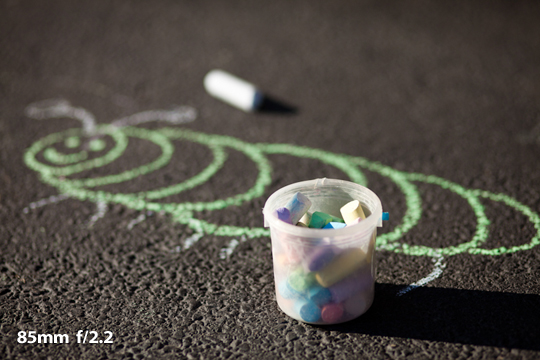
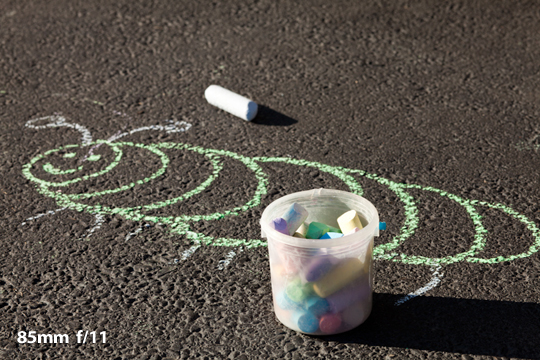
To give you a good idea of what different apertures look like at different focal lengths (and how various lenses, look), here’s the same image shot with three different lenses, but at the same apertures. The model stood in the same position for each shot with all three lenses. The three lenses used were the 35mm 1.4, 85mm 1.8 and the 70-200mm 2.8. Notice that the longer focal lengths compress the subject and background.
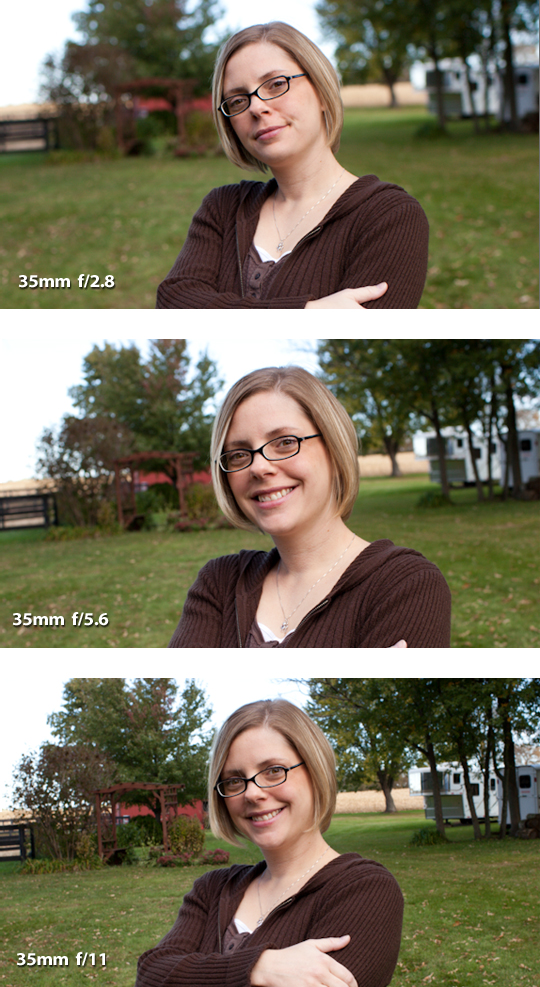
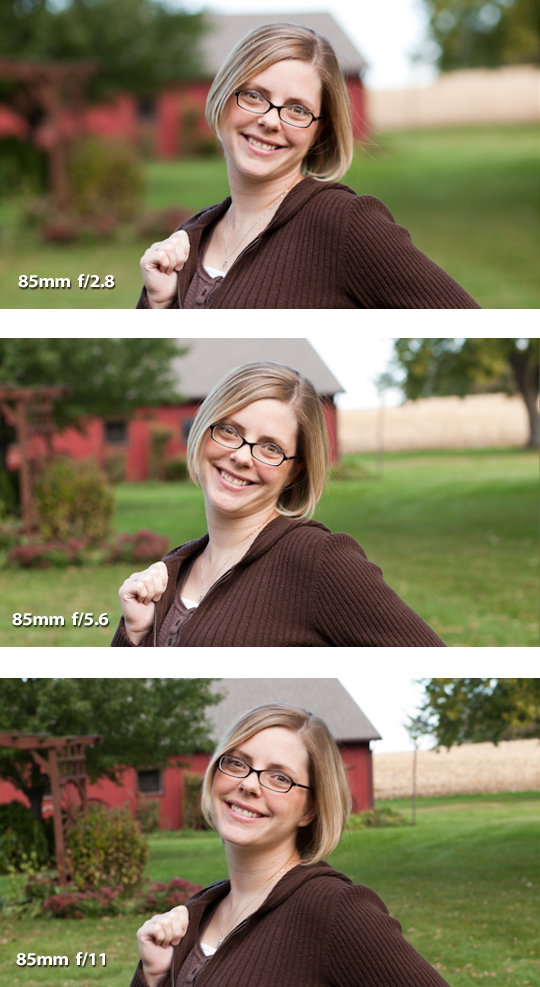
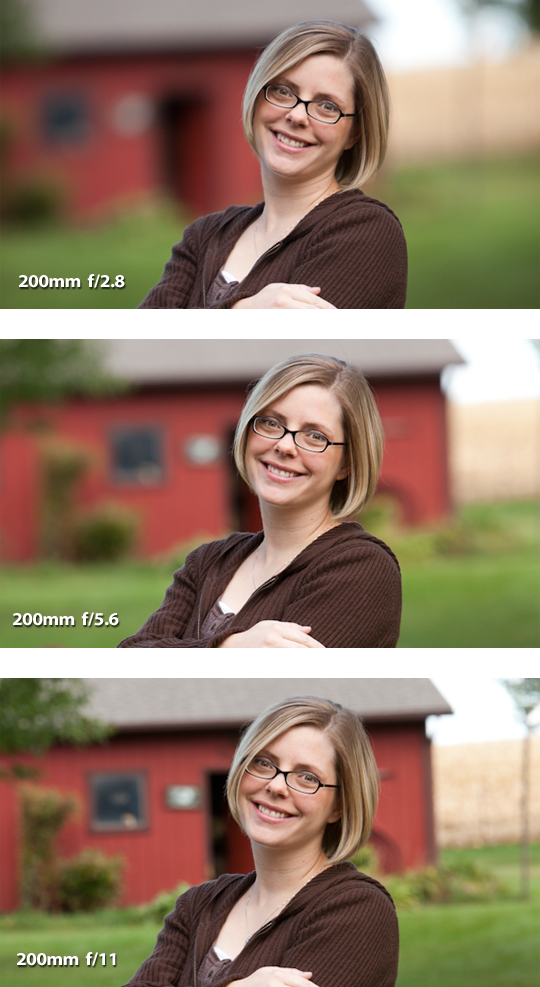
All Photos © Ryan Klos
Does brand matter?
Most camera manufacturers make their own lenses, but you can also purchase third-party lenses from brands like Sigma, Tamron or Tokina, to name a few. Many reviewers favor keeping the brand of lens consistent with the body, and I agree. But that doesn’t mean third-party lenses aren’t worth looking into. Many of them get great reviews, and you’re likely to save some green. In many cases, you’d have a hard time seeing a difference in image quality unless you’re pixel peeping. Just be sure to do your research.
The best way to know if a lens works for you is to shoot with it. Check out Borrowlenses.com to rent a lens and put it through its paces. It’s a fraction of the cost to rent, and you’re not committing a large sum to something that may not be exactly what you want.
Lenses are an investment. You’ll use them on all your future cameras, so don’t go cheap for the sake of being cheap. Go for quality – good glass on a low-end body can make some great images, but the opposite isn’t always true. Good glass is one case where you truly get what you pay for.


